Influence of Road Types on Transiting Test for Aerodynamic Coefficient Measurements Using Passive Wind Generated by a Moving Vehicle
Abstract
1. Introduction
2. Experimental Setup
2.1. Experimental Devices
2.2. Prism Model and Test Conditions
2.3. Specific Assumptions
2.4. Theoretical Modeling
3. Results and Discussion
3.1. Impact of Natural Wind on the Test
3.2. Coefficient of Variation of Vehicle-Driving Wind Speed
3.3. Stability Analysis of the Aerodynamic Forces and Vibration Accelerations
3.4. Influence of Road Types on Aerodynamic Coefficients
3.5. Effect of End Plates on the Aerodynamic Coefficients
3.6. Comparison of the Influence of Road Types and Effect of End Plates
4. Conclusions
- The coefficient of variation of vehicle-driving wind speed of the expressway, viaduct highway, and tunnel highway in the transiting tests were close to or even smaller than 4% under several conditions similar to those of the wind tunnel test, as follows: 3 °C temperature, 42% humidity, 0.28 m/s natural wind speed, vehicle driving at a stable speed in straight line, and no traffic flow.
- In the transiting test under the aforementioned conditions, the tendency of the aerodynamic coefficients of the test model with the change of wind attack angles showed satisfactory consistency with that of the wind tunnel test. The results of the transiting test demonstrated satisfactory repeatability.
- In comparison with the wind tunnel test, the drag coefficients of the test model in the transiting test without end plates were generally smaller, whereas those of the test model with end plates were in good agreement with the wind tunnel test.
- The results obtained from the expressway were the most consistent with those from the wind tunnel test. In future research, transiting tests should be carried out on the expressway under the aforementioned conditions, with end plates installed on both ends of the test model.
Author Contributions
Funding
Institutional Review Board Statement
Informed Consent Statement
Data Availability Statement
Acknowledgments
Conflicts of Interest
References
- Li, Y.; Tian, X.; Tee, K.F.; Li, Q.; Li, Y. Aerodynamic treatments for reduction of wind loads on high-rise buildings. J. Wind Eng. Ind. Aerodyn. 2018, 172, 107–115. [Google Scholar] [CrossRef]
- Sy, L.D.; Yamada, H.; Katsuchi, H. Interference effects of wind-over-top flow on high-rise buildings. J. Wind Eng. Ind. Aerodyn. 2019, 187, 85–96. [Google Scholar] [CrossRef]
- Ge, Y.J.; Xiang, H.F. Computational models and methods for aerodynamic flutter of long-span bridges. J. Wind Eng. Ind. Aerodyn. 2008, 96, 1912–1924. [Google Scholar] [CrossRef]
- Mashnad, M.; Jones, N.P. A model for vortex-induced vibration analysis of long-span bridges. J. Wind Eng. Ind. Aerodyn. 2014, 134, 96–108. [Google Scholar] [CrossRef]
- Choi, E.C.C. Field measurement and experimental study of wind speed profile during thunderstorms. J. Wind Eng. Ind. Aerodyn. 2004, 92, 275–290. [Google Scholar] [CrossRef]
- Huang, G.; Jiang, Y.; Peng, L.; Solari, G.; Liao, H.; Li, M. Characteristics of intense winds in mountain area based on field measurement: Focusing on thunderstorm winds. J. Wind Eng. Ind. Aerodyn. 2019, 190, 166–182. [Google Scholar] [CrossRef]
- Buccolieri, R.; Sandberg, M.; Wigö, H.; di Sabatino, S. The drag force distribution within regular arrays of cubes and its relation to cross ventilation—Theoretical and experimental analyses. J. Wind Eng. Ind. Aerodyn. 2019, 189, 91–103. [Google Scholar] [CrossRef]
- Alminhana, G.W.; Braun, A.L.; Loredo-Souza, A.M. A numerical-experimental investigation on the aerodynamic performance of CAARC building models with geometric modifications. J. Wind Eng. Ind. Aerodyn. 2018, 180, 34–48. [Google Scholar] [CrossRef]
- Noguchi, Y.; Suzuki, M.; Baker, C.; Nakade, K. Numerical and experimental study on the aerodynamic force coefficients of railway vehicles on an embankment in crosswind. J. Wind Eng. Ind. Aerodyn. 2019, 184, 90–105. [Google Scholar] [CrossRef]
- Diana, G.; de Ponte, S.; Falco, M.; Zasso, A. A new large wind tunnel for civil-environmental and aeronautical applications. J. Wind Eng. Ind. Aerodyn. 1998, 74–76, 553–565. [Google Scholar] [CrossRef]
- Diana, G.; Yamasaki, Y.; Larsen, A.; Rocchi, D.; Giappino, S.; Argentini, T.; Pagani, A.; Villani, M.; Somaschini, C.; Portentoso, M. Construction stages of the long span suspension Izmit Bay Bridge: Wind tunnel test assessment. J. Wind Eng. Ind. Aerodyn. 2013, 123, 300–310. [Google Scholar] [CrossRef]
- Jeong, H.; Lee, S.; Kwon, S.D. Blockage corrections for wind tunnel tests conducted on a Darrieus wind turbine. J. Wind Eng. Ind. Aerodyn. 2018, 179, 229–239. [Google Scholar] [CrossRef]
- Tang, Z.; Liu, P.; Sun, J.; Chen, Y.; Hao, G.; Li, G. Performance of Contra-Rotating Propellers for Stratospheric Airships. Int. J. Aeronaut. Space Sci. 2015, 16, 485–492. [Google Scholar] [CrossRef][Green Version]
- Li, S.; Wan, R.; Wang, D.; Guo, P. Effect of end plates on transiting test for measuring the aerodynamic coefficient of structures using wind generated by a moving vehicle. J. Wind Eng. Ind. Aerodyn. 2019, 190, 273–286. [Google Scholar] [CrossRef]
- Li, S.; Liu, L.; Wu, H.; Jiang, N.; Zheng, S.; Guo, P. New test method of wind pressure coefficient based on CAARC standard model determined using vehicle driving wind. Exp. Tech. 2019, 43, 707–717. [Google Scholar] [CrossRef]
- Li, S.; Liang, J.; Zheng, S.; Jiang, N.; Liu, L.; Guo, P. A novel test method for aerodynamic coefficient measurements of structures using wind generated by a moving vehicle. Exp. Tech. 2019, 43, 677–693. [Google Scholar] [CrossRef]
- Alonso, G.; Meseguer, J. A parametric study of the galloping stability of two-dimensional triangular cross-section bodies. J. Wind Eng. Ind. Aerodyn. 2006, 94, 241–253. [Google Scholar] [CrossRef]
- Alonso, G.; Meseguer, J.; Pérez-Grande, I. Galloping stability of triangular cross-sectional bodies: A systematic approach. J. Wind Eng. Ind. Aerodyn. 2007, 95, 928–940. [Google Scholar] [CrossRef]
- Hui, M.C.H.; Zhou, Z.Y.; Chen, A.R.; Xiang, H.F. The effect of Reynolds numbers on the steady state aerodynamic force coefficients of the Stonecutters Bridge deck section. Wind Struct. 2008, 11, 179–192. [Google Scholar] [CrossRef]
- Lee, S.; Kwon, S.; Yoon, J. Reynolds number sensitivity to aerodynamic forces of twin box bridge girder. J. Wind Eng. Ind. Aerodyn. 2014, 127, 59–68. [Google Scholar] [CrossRef]
- Mcauliffe, B.R.; Belluz, L.; Belzile, M. Measurement of the On-Road Turbulence Environment Experienced by Heavy Duty Vehicles. SAE Int. J. Commer. Veh. 2014, 7, 685–702. [Google Scholar] [CrossRef]
- Pu, Y.; Chen, F.; Chen, P.; Pan, X. Wind data collection and analysis of topographical features along a highway for traffic safety assessment based on mobile mapping technology. Transp. Res. Rec. 2018, 2672, 292–301. [Google Scholar] [CrossRef]
- Wordley, S.; Saunders, J.W. On-road Turbulence: Part 1. SAE Int. J. Passeng. Cars Mech. Syst. 2008, 1, 341–360. [Google Scholar] [CrossRef]
- Wordley, S.; Saunders, J.W. On-road Turbulence: Part 2. SAE Int. J. Passeng. Cars Mech. Syst. 2009, 2, 111–137. [Google Scholar] [CrossRef]
- Choi, J.K.; Kim, K.H. Effects of nose shape and tunnel cross-sectional area on aerodynamic drag of train traveling in tunnels. Tunn. Undergr. Space Technol. 2014, 41, 62–73. [Google Scholar] [CrossRef]
- Muñoz-Paniagua, J.; García, J.; Crespo, A. Genetically aerodynamic optimization of the nose shape of a high-speed train entering a tunnel. J. Wind Eng. Ind. Aerodyn. 2014, 130, 48–61. [Google Scholar] [CrossRef]
- He, X.H.; Zou, Y.F.; Wang, H.F.; Han, Y.; Shi, K. Aerodynamic characteristics of a trailing rail vehicles on viaduct based on still wind tunnel experiments. J. Wind Eng. Ind. Aerodyn. 2014, 135, 22–33. [Google Scholar] [CrossRef]
- Guo, P.; Li, S.; Wang, C.; Hu, Y.; Wang, D. Influence of catwalk design parameters on the galloping of constructing main cables in long-span suspension bridges. J. Vibroeng. 2017, 19, 4671–4684. [Google Scholar]
- Wang, X.; Gu, M. Experimental investigation of Reynolds number effects on 2D rectangular prisms with various side ratios and rounded corners. Wind Struct. 2015, 21, 183–202. [Google Scholar] [CrossRef]
- Agostinacchio, M.; Ciampa, D.; Olita, S. The vibrations induced by surface irregularities in road pavements—A Matlab® approach. Eur. Transp. Res. Rev. 2014, 6, 267–275. [Google Scholar] [CrossRef]
- Haigermoser, A.; Luber, B.; Rauh, J.; Fe, G.G. Road and track irregularities: Measurement, assessment and simulation. Veh. Syst. Dyn. 2015, 53, 878–957. [Google Scholar] [CrossRef]
- Li, Y.; Hu, P.; Xu, Y.; Zhang, M.; Liao, H. Wind loads on a moving vehicle-bridge deck system by wind-tunnel model test. Wind Struct. 2014, 19, 145–167. [Google Scholar] [CrossRef]
- Li, B.; Yang, Q.; Yang, J. Wind characteristics near ground in south-eastern coast area of China based on field measurement. Geomat. Nat. Hazards Risk 2016, 7, 57–69. [Google Scholar] [CrossRef]
- Xu, F.; Cai, C.; Zhang, Z. Investigations on coefficient of variation of extreme wind speed. Wind Struct. 2014, 18, 633–650. [Google Scholar] [CrossRef]
- Watkins, S.; Saunders, J.W.; Hoffmann, P.H. Turbulence experienced by moving vehicles. Part I. Introduction and turbulence intensity. J. Wind Eng. Ind. Aerodyn. 1995, 57, 1–17. [Google Scholar] [CrossRef]
- An, Y.; Wang, C.; Li, S.; Wang, D. Galloping of steepled main cables in long-span suspension bridges during construction. Wind Struct. 2016, 23, 595–613. [Google Scholar] [CrossRef]
- Li, S.; An, Y.; Wang, C.; Wang, D. Experimental and numerical studies on galloping of the flat-topped main cables for the long span suspension bridge during construction. J. Wind Eng. Ind. Aerodyn. 2017, 163, 24–32. [Google Scholar] [CrossRef]
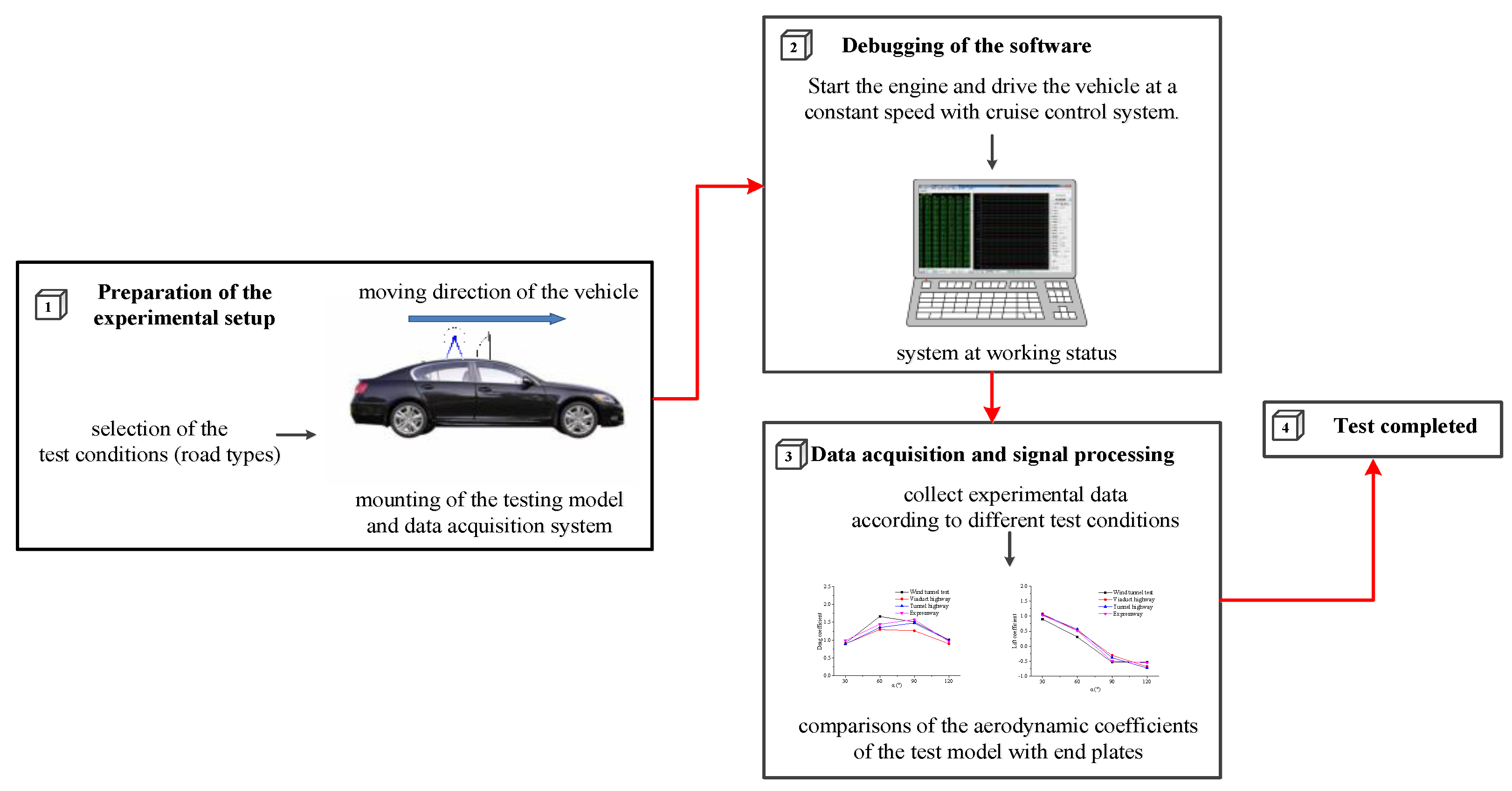
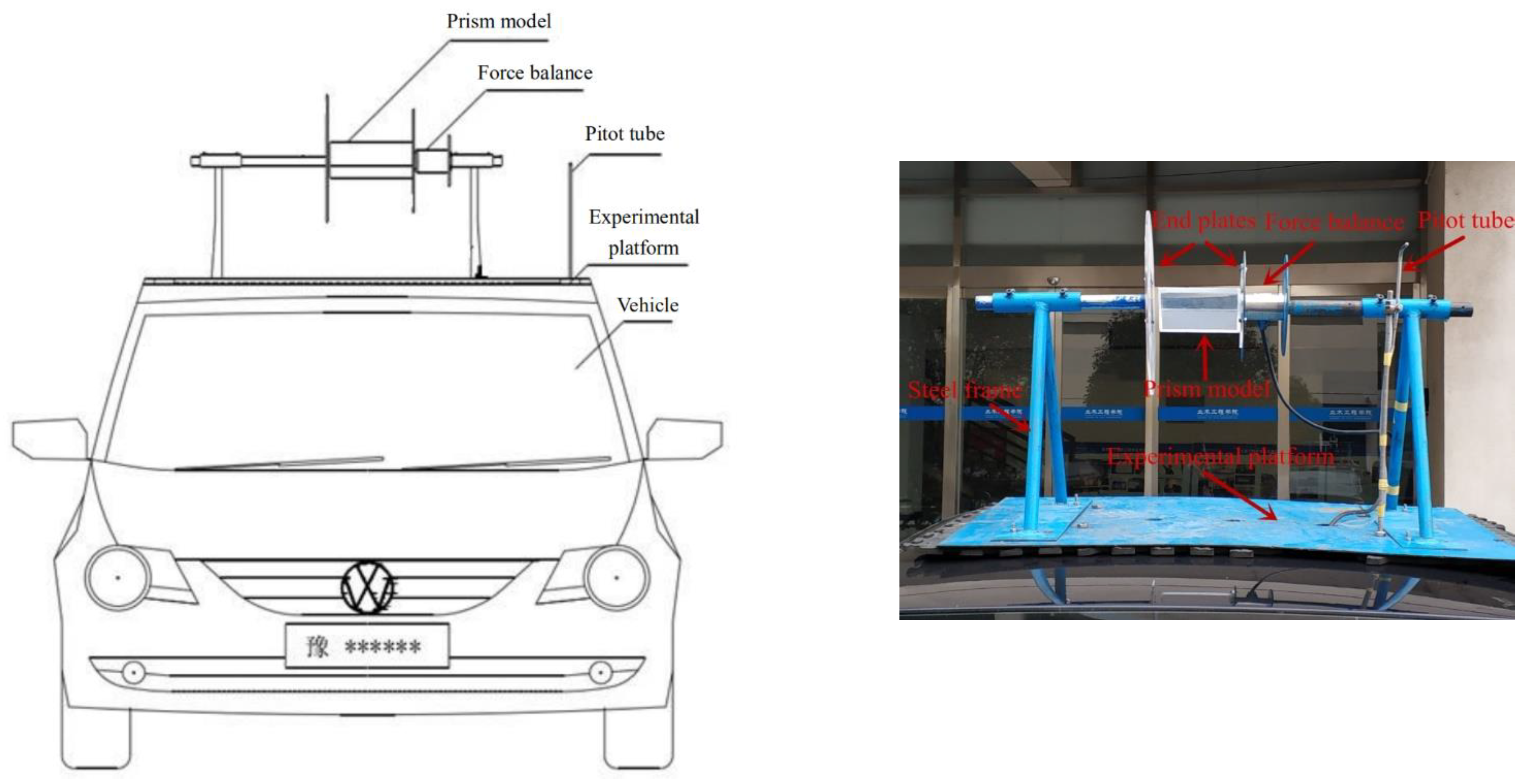
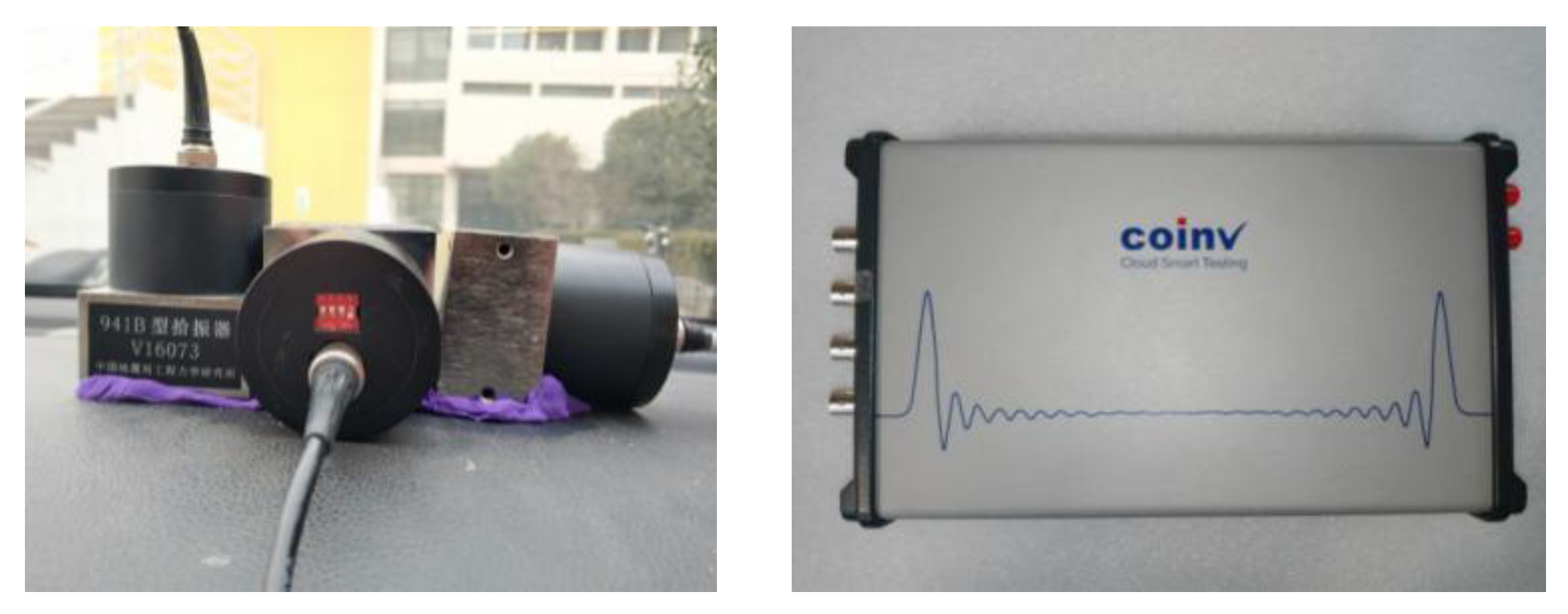

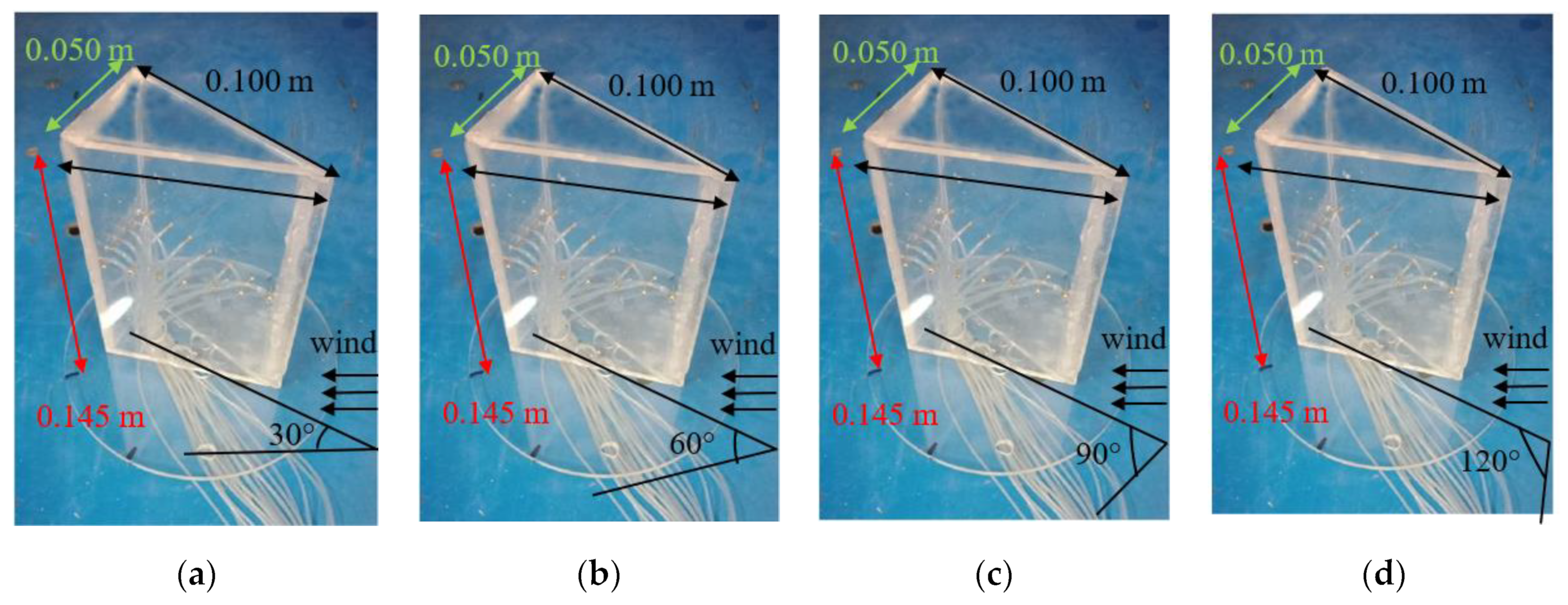
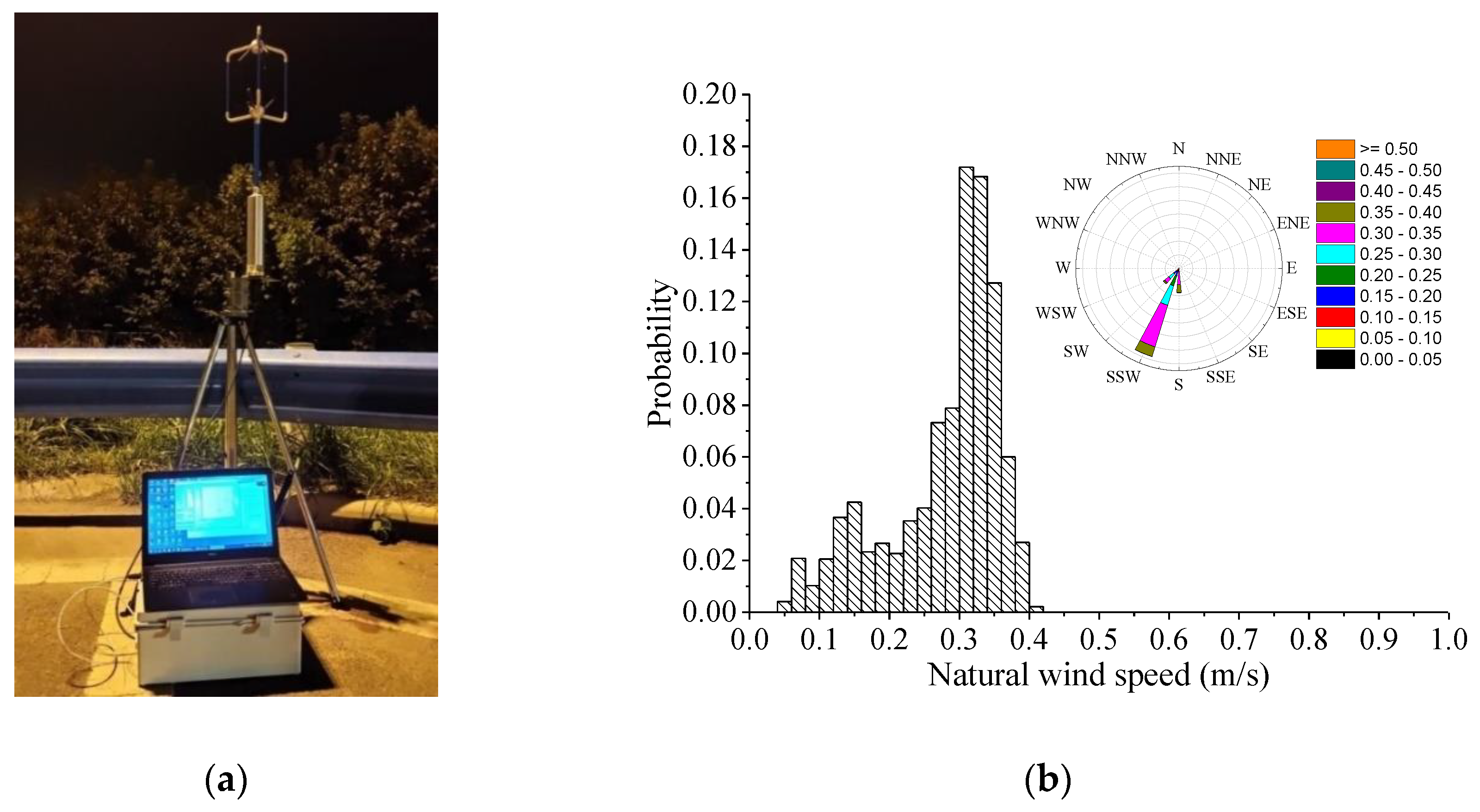
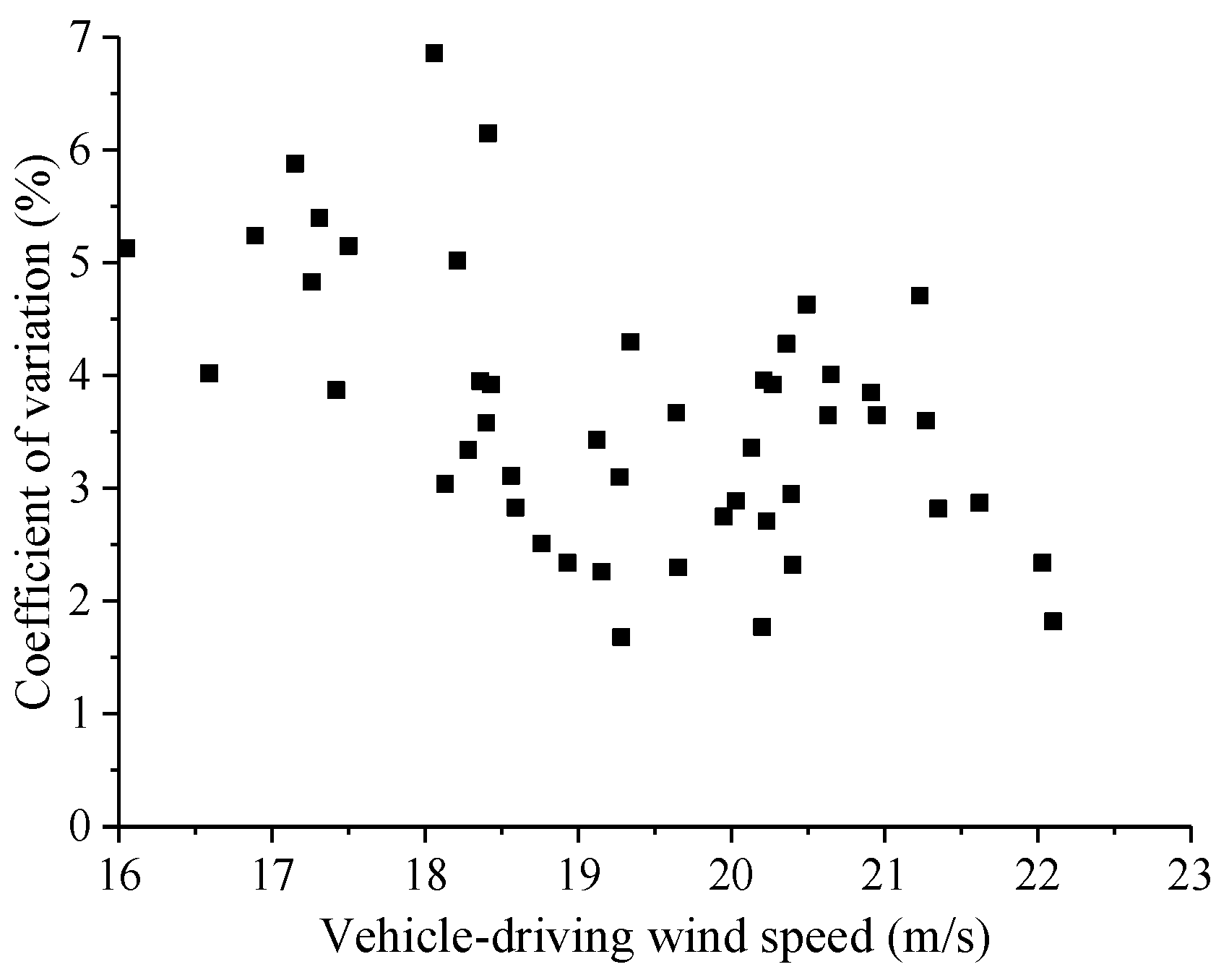







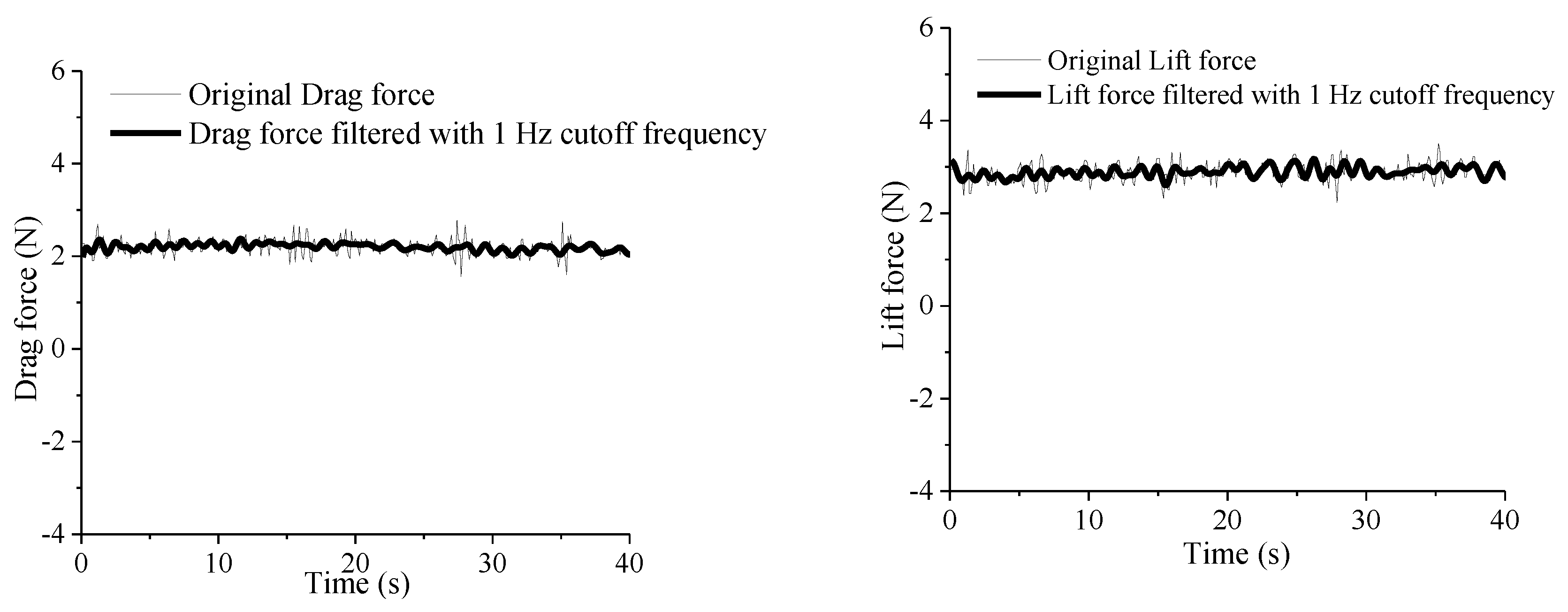

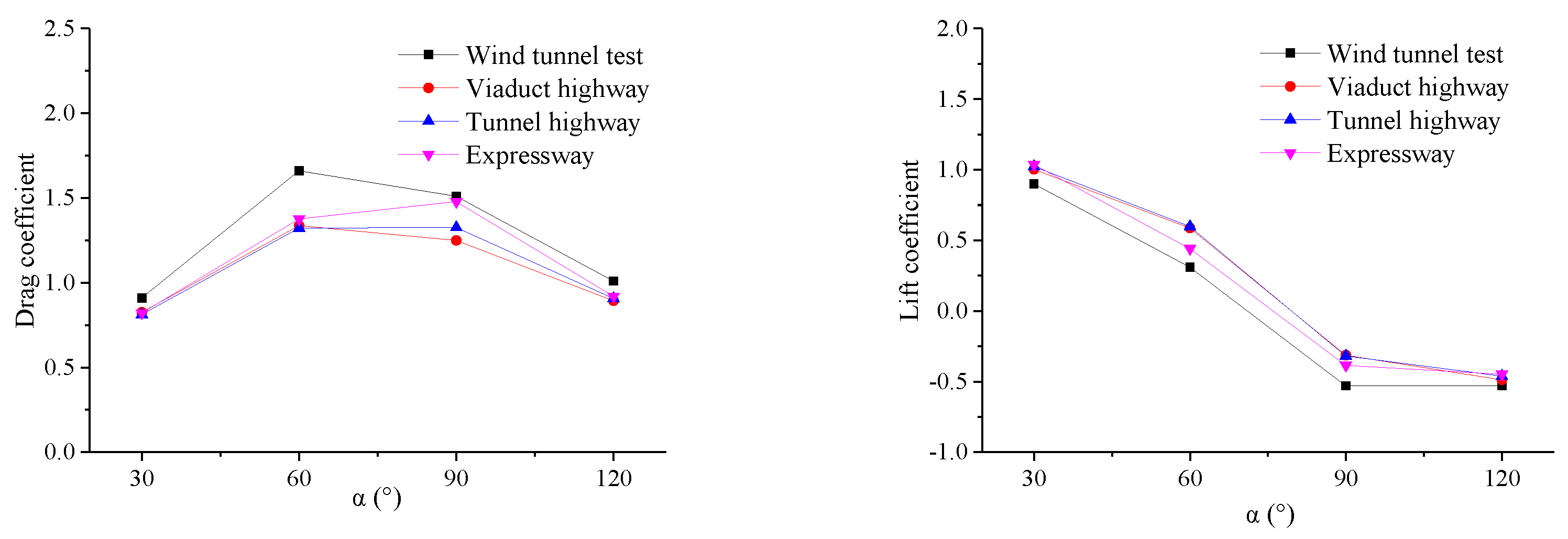


| Test Devices | Purpose |
|---|---|
| Ultra-low-frequency accelerometers and Data collecting instrument | Measurement of wind speed and direction |
| Pitot tube and Demodulation instrument | Measurement of air pressure |
| Vibration accelerometer and Intelligent control instrument | Measurement of vibration acceleration |
| Force balance | Measurement of lift and drag forces. |
| Test Conditions | Road Types | End Plate Conditions | Wind Attack Angles | Acquisition Time |
|---|---|---|---|---|
| Expressway, no end plates | Expressway | No end plates | 30°, 60°, 90°, 120° | 100 s |
| Expressway, end plates | End plates | |||
| Viaduct highway, no end plates | Viaduct highway | No end plates | ||
| Viaduct highway, end plates | End plates | |||
| Tunnel highway, no end plates | Tunnel highway | No end plates | ||
| Tunnel highway, end plates | End plates |
| Interfering Factors | Interference Mitigations |
|---|---|
| Vibrations induced by irregular motion of the vehicle | Tests conducted in straight road with flat surface, use of Cruise Control System |
| Ancillary facilities (road greening, etc.) along the highway | Vehicle driven in center of the lane |
| Traffic density | Tests carried out at night |
| Natural wind, temperature, and humidity | Tests done with 0.28 m/s natural wind speed, 3 °C temperature, and 42% humidity |
| Boundary layer (less than 10 cm) of the vehicle roof | At least a distance of 30 cm between the test model and experimental platform |
| Vibration of the test model | Use of steel frame to fix the plexiglass model to the experimental platform |
| Data acquisition system | Instruments placed in the vehicle with cables well arranged |
| Test Conditions | Wind Attack Angles | ||||
|---|---|---|---|---|---|
| 30° | 60° | 90° | 120° | Average | |
| Expressway, no end plates | 2.80 | 4.41 | 3.77 | 3.78 | 3.69 |
| Expressway, end plates | 2.55 | 6.78 | 1.93 | 2.62 | 3.47 |
| Viaduct highway, no end plate | 2.30 | 4.14 | 3.38 | 3.14 | 3.24 |
| Viaduct highway, end plate | 3.92 | 6.15 | 1.68 | 2.45 | 3.55 |
| Tunnel highway, no end plate | 2.05 | 3.23 | 2.49 | 1.77 | 2.39 |
| Tunnel highway, end plate | 3.36 | 3.16 | 2.32 | 1.83 | 2.67 |
| Wind tunnel test [29,30] | ≤4.00 | ||||
| Aerodynamic Coefficients | Test Conditions | Wind Attack Angles | |||
|---|---|---|---|---|---|
| 30° | 60° | 90° | 120° | ||
| Drag force coefficients | Expressway, no end plates | 0.45 | 3.88 | 3.06 | 5.04 |
| Expressway, end plates | 1.05 | 4.23 | 0.76 | 2.93 | |
| Viaduct highway, no end plates | 5.98 | 2.15 | 1.74 | 2.63 | |
| Viaduct highway, end plates | 1.79 | 2.80 | 1.09 | 2.00 | |
| Tunnel highway, no end plates | 2.36 | 1.10 | 5.38 | 2.49 | |
| Tunnel highway, end plates | 4.50 | 4.83 | 2.65 | 1.70 | |
| Lift force coefficients | Expressway, no end plates | 1.30 | 1.36 | 2.35 | 4.64 |
| Expressway, end plates | 0.46 | 3.35 | 4.16 | 2.44 | |
| Viaduct highway, no end plates | 5.58 | 3.03 | 2.30 | 1.39 | |
| Viaduct highway, end plates | 2.59 | 2.29 | 1.73 | 1.56 | |
| Tunnel highway, no end plates | 2.35 | 4.52 | 2.74 | 0.59 | |
| Tunnel highway, end plates | 5.71 | 1.77 | 1.30 | 0.96 | |
Publisher’s Note: MDPI stays neutral with regard to jurisdictional claims in published maps and institutional affiliations. |
© 2022 by the authors. Licensee MDPI, Basel, Switzerland. This article is an open access article distributed under the terms and conditions of the Creative Commons Attribution (CC BY) license (https://creativecommons.org/licenses/by/4.0/).
Share and Cite
Zhang, X.; Hou, L.; Hao, Y.; Zheng, X.; Wan, R.; Ren, D.; Li, S. Influence of Road Types on Transiting Test for Aerodynamic Coefficient Measurements Using Passive Wind Generated by a Moving Vehicle. Processes 2022, 10, 1471. https://doi.org/10.3390/pr10081471
Zhang X, Hou L, Hao Y, Zheng X, Wan R, Ren D, Li S. Influence of Road Types on Transiting Test for Aerodynamic Coefficient Measurements Using Passive Wind Generated by a Moving Vehicle. Processes. 2022; 10(8):1471. https://doi.org/10.3390/pr10081471
Chicago/Turabian StyleZhang, Xiaoli, Linjie Hou, Yanbo Hao, Xufen Zheng, Ru Wan, Duochang Ren, and Shengli Li. 2022. "Influence of Road Types on Transiting Test for Aerodynamic Coefficient Measurements Using Passive Wind Generated by a Moving Vehicle" Processes 10, no. 8: 1471. https://doi.org/10.3390/pr10081471
APA StyleZhang, X., Hou, L., Hao, Y., Zheng, X., Wan, R., Ren, D., & Li, S. (2022). Influence of Road Types on Transiting Test for Aerodynamic Coefficient Measurements Using Passive Wind Generated by a Moving Vehicle. Processes, 10(8), 1471. https://doi.org/10.3390/pr10081471






